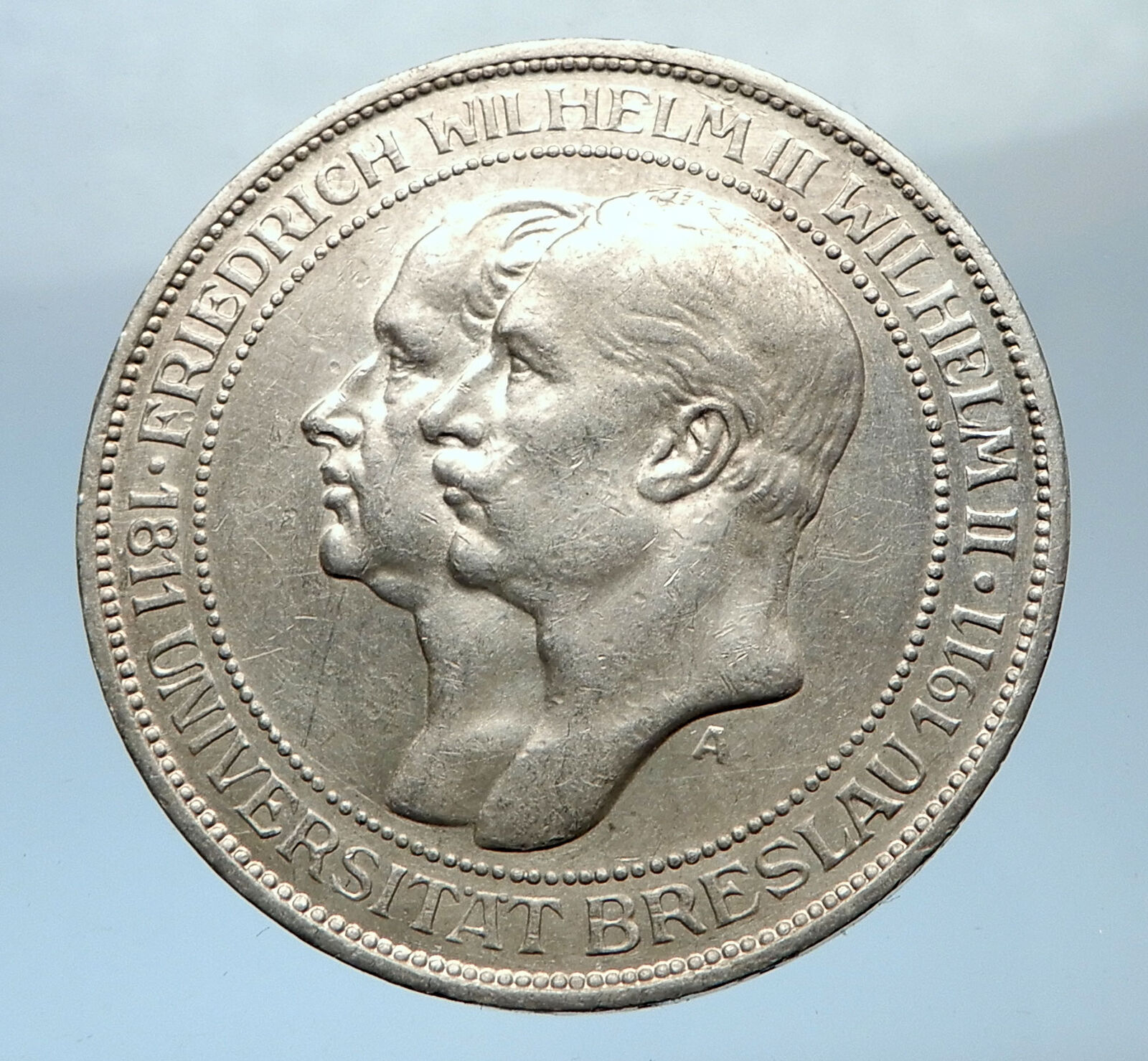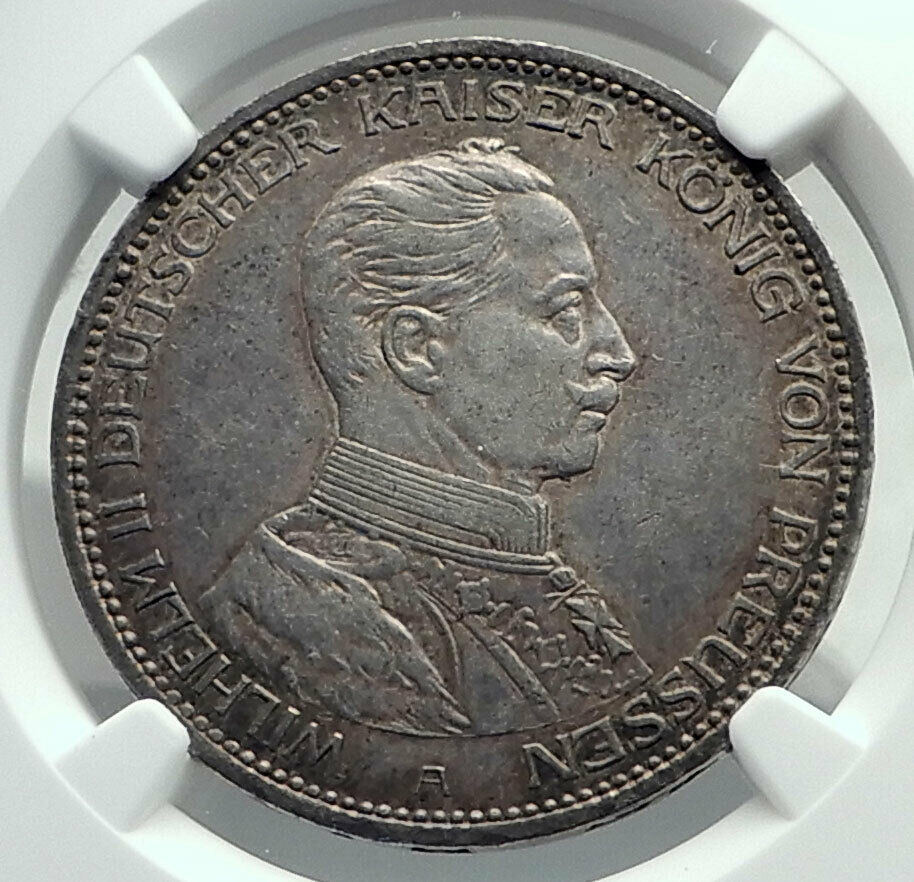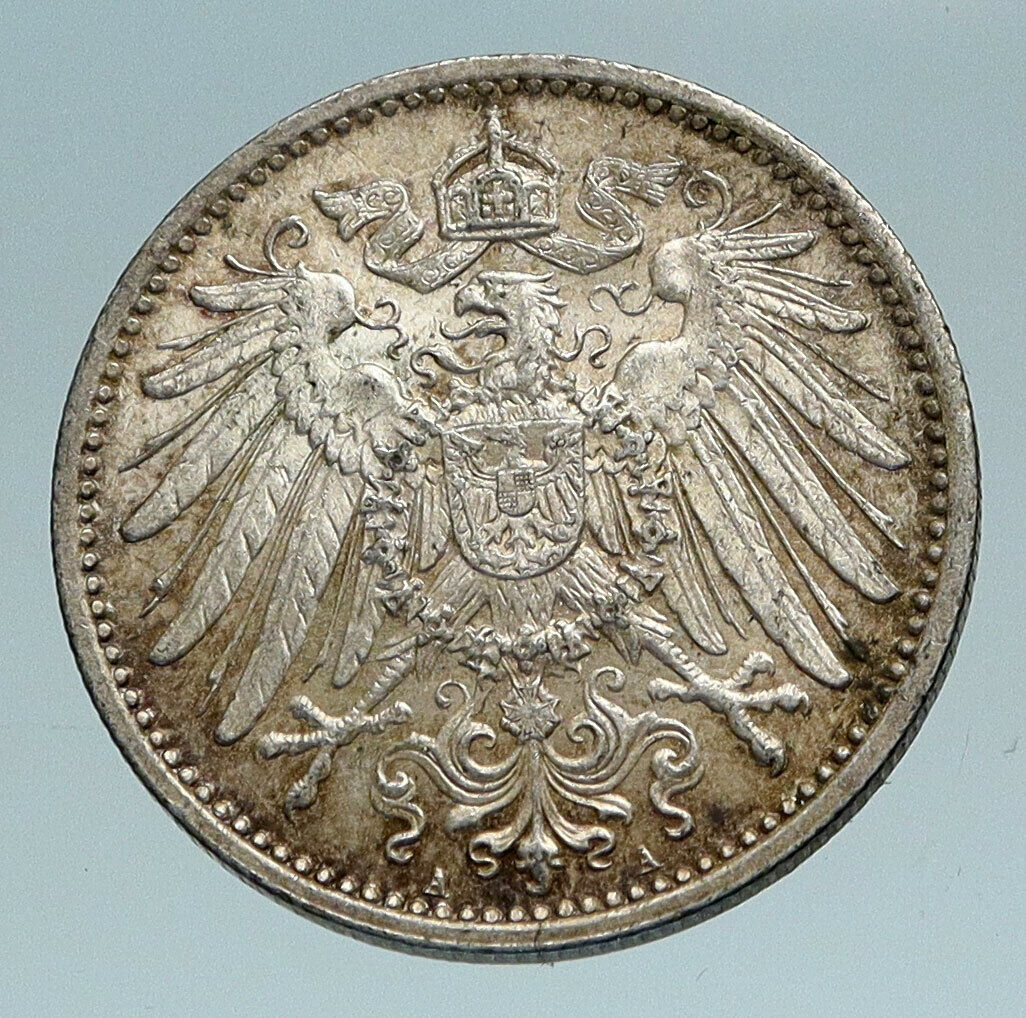|
Germany – German States – Electorate of Saxony
Frederick Augustus III – King of Saxony: 15 October 1904 – 13 November 1918
1908 E Silver 5 Mark 38mm (27.77 grams) 0.900 Silver (0.8037 oz. ASW)
Reference: KM# 1266 (1907-14)
Certification: NGC XF DETAILS 2863618-013
FRIEDRICH AUGUST KÖNIG V. SACHSEN, Friedrich facing right.
DEUTSCHES REICH * FÜNF MARK *, Crowned imperial eagle with shield on breast.
Edge Lettering: GOTT MIT UNS
You are bidding on the exact item pictured, provided with a Certificate of Authenticity and Lifetime Guarantee of Authenticity.
 Frederick Augustus III (German: Friedrich August III.; 25 May 1865 – 18 February 1932), and a member of the House of Wettin, was the last King of Saxony (1904-1918). Born in Dresden, Frederick Augustus was the eldest son of King George of Saxony and his wife, Maria Anna of Portugal. Frederick Augustus III (German: Friedrich August III.; 25 May 1865 – 18 February 1932), and a member of the House of Wettin, was the last King of Saxony (1904-1918). Born in Dresden, Frederick Augustus was the eldest son of King George of Saxony and his wife, Maria Anna of Portugal.
Frederick Augustus served in the Royal Saxon Army before becoming king, and later was promoted to Generalfeldmarschall. Though well-loved by his subjects, he voluntarily abdicated as king on 13 November 1918, after the defeat of the German Empire in World War I. He died in Sibyllenort (now Szczodre) in Lower Silesia and was buried in Dresden.
Frederick Augustus entered the Royal Saxon Army in 1877 as a second lieutenant, despite being only twelve years old. Given his royal status, he advanced rapidly through the ranks. He served initially with the Royal Saxon 1. (Leib-) Grenadier Regiment Nr. 100. He was promoted to first lieutenant in 1883, captain in 1887, major in 1889 and lieutenant colonel in 1891. By 1891, he was commander of the 1st Battalion of Schützen (Füsilier)-Regiment Nr. 108. He was promoted to colonel on 22 September 1892 and took command of the Schützen (Füsilier)-Regiment Nr. 108 on the same day. On 20 September 1894, the 29-year-old prince was promoted to Generalmajor and given command of the 1st Royal Saxon Infantry Brigade Nr. 45 (Saxon higher units usually bore two numbers: one their Saxon Army number and the other their number in the Prussian Army order of battle). On 22 May 1898, he was promoted to Generalleutnant and given command of the 1st Royal Saxon Infantry Division Nr. 23. He commanded this division until 26 August 1902, when he took command of the XII (1st Royal Saxon) Corps. He was promoted to General der Infanterie one month later, on 24 September. He remained in command of the corps until October 1904, when he became king. His military career effectively ended with his accession to the throne, but he was promoted subsequently to Generaloberst and then to Generalfeldmarschall (on 9 September 1912).
Following his father’s accession, he was in July 1902 appointed à la suite of the German Marine Infantry by Emperor Wilhelm II during a visit to Kiel.
 Saxony (German: Sachsen, Upper Sorbian: Sakska), officially the Free State of Saxony, Upper Sorbian: Swobodny stat Sakska), is a landlocked federal state of Germany, bordering the federal states of Brandenburg, Saxony Anhalt, Thuringia, and Bavaria, as well as the countries of Poland (Lower Silesian and Lubusz Voivodeships) and the Czech Republic (Karlovy Vary, Liberec, and Ústí nad Labem Regions). Its capital is Dresden, and its largest city is Leipzig. Saxony (German: Sachsen, Upper Sorbian: Sakska), officially the Free State of Saxony, Upper Sorbian: Swobodny stat Sakska), is a landlocked federal state of Germany, bordering the federal states of Brandenburg, Saxony Anhalt, Thuringia, and Bavaria, as well as the countries of Poland (Lower Silesian and Lubusz Voivodeships) and the Czech Republic (Karlovy Vary, Liberec, and Ústí nad Labem Regions). Its capital is Dresden, and its largest city is Leipzig.
Saxony is the tenth largest of Germany’s sixteen states, with an area of 18,413 square kilometres (7,109 sq mi), and the sixth most populous, with 4 million people.
 The history of the state of Saxony spans more than a millennium. It has been a medieval duchy, an electorate of the Holy Roman Empire, a kingdom, and twice a republic. The history of the state of Saxony spans more than a millennium. It has been a medieval duchy, an electorate of the Holy Roman Empire, a kingdom, and twice a republic.
The area of the modern state of Saxony should not be confused with Old Saxony, the area inhabited by Saxons. Old Saxony corresponds roughly to the modern German states of Lower Saxony, Saxony-Anhalt, and the Westphalian part of North Rhine-Westphalia.
|









 Frederick Augustus III (German: Friedrich August III.; 25 May 1865 – 18 February 1932), and a member of the House of Wettin, was the last King of Saxony (1904-1918). Born in Dresden, Frederick Augustus was the eldest son of King George of Saxony and his wife, Maria Anna of Portugal.
Frederick Augustus III (German: Friedrich August III.; 25 May 1865 – 18 February 1932), and a member of the House of Wettin, was the last King of Saxony (1904-1918). Born in Dresden, Frederick Augustus was the eldest son of King George of Saxony and his wife, Maria Anna of Portugal.  Saxony (German: Sachsen, Upper Sorbian: Sakska), officially the Free State of Saxony, Upper Sorbian: Swobodny stat Sakska), is a landlocked federal state of Germany, bordering the federal states of Brandenburg, Saxony Anhalt, Thuringia, and Bavaria, as well as the countries of Poland (Lower Silesian and Lubusz Voivodeships) and the Czech Republic (Karlovy Vary, Liberec, and Ústí nad Labem Regions). Its capital is Dresden, and its largest city is Leipzig.
Saxony (German: Sachsen, Upper Sorbian: Sakska), officially the Free State of Saxony, Upper Sorbian: Swobodny stat Sakska), is a landlocked federal state of Germany, bordering the federal states of Brandenburg, Saxony Anhalt, Thuringia, and Bavaria, as well as the countries of Poland (Lower Silesian and Lubusz Voivodeships) and the Czech Republic (Karlovy Vary, Liberec, and Ústí nad Labem Regions). Its capital is Dresden, and its largest city is Leipzig.  The history of the state of Saxony spans more than a millennium. It has been a medieval duchy, an electorate of the Holy Roman Empire, a kingdom, and twice a republic.
The history of the state of Saxony spans more than a millennium. It has been a medieval duchy, an electorate of the Holy Roman Empire, a kingdom, and twice a republic. 




